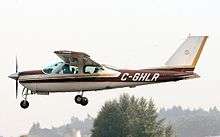Proteus Airlines Flight 706
| Accident summary | |
|---|---|
| Date | July 30, 1998 |
| Summary | Mid-air collision |
| Site | Quiberon Bay |
| Total fatalities | 15 (all) |
| Total survivors | 0 |
| First aircraft | |
.jpg) A Beechcraft 1900D of Proteus Airlines, similar to the accident aircraft | |
| Type | Beechcraft 1900D |
| Operator | Proteus Airlines |
| Registration | F-GSJM |
| Flight origin |
Lyon Satolas Airport Lyon, France |
| Destination |
Lorient-Lann Bihoué Airport Lorient, France |
| Passengers | 12 |
| Crew | 2 |
| Fatalities | 14 |
| Survivors | 0 |
| Second aircraft | |
 A Cessna 177RG Cardinal, similar to the accident aircraft | |
| Type | Cessna 177RG Cardinal |
| Operator | Private |
| Registration | F-GAJE |
| Flight origin |
Vannes Airport Meucon, France |
| Passengers | 0 |
| Crew | 1 |
| Fatalities | 1 |
| Survivors | 0 |
Proteus Airlines Flight 706 was a scheduled commuter flight from Lyon, France to Lorient, France. On July 30, 1998 the Beechcraft 1900D operating the flight collided in mid-air with a light aircraft over Quiberon Bay. Both aircraft crashed in the sea, killing fifteen people.
Accident
Flight 706 took off from Lyon–Saint-Exupéry at 12:21 local time on a flight to Lorient Lann-Bihoué airport. About seventy minutes into the flight, the crew made a request to the Lorient approach controller to deviate from their route slightly to the west to Quiberon Bay.[1] The reason for this detour was to give the passengers and crew a view of the SS Norway, at that time the longest ocean liner ever built in France. Later examinations of the 1900D's cockpit voice recorder revealed that a passenger made his way to the cockpit and told the pilot and co-pilot of the presence of the Norway nearby, then suggested that the crew fly the aircraft closer to the ship.[2]:21-22 At the time of this request, a Cessna 177 registered F-GAJE belonging to a local flying club took off from the airfield at Vannes for a local flight to Quiberon.[3]
At 13:53, after first being cleared to descend to 3,700 feet (1,100 m) over the bay, the Proteus crew canceled their instrument flight rules and decided to use visual flight rules, descending from 2,500 feet (760 m) to 2,000 feet (610 m) while making a 360° turn around the ship.[2]:9 At 13:56 the pilot of the Cessna contacted the flight information service at Quiberon as he passed Larmor-Baden and informed them of his intent to descend from 3,000 feet (910 m) to 1,500 feet (460 m).[2]:9 At 13:57 the Proteus crew announced to the Lorient approach controller that they had reached the end of their 360° turn and asked to take a direct course for Lorient.[2]:18 After receiving confirmation of this request at 13:58, the two aircraft collided. Both aircraft immediately fell to the water, killing all 14 passengers and crew on board the Beechcraft, as well as the sole occupant of the Cessna.[4]
Investigation
The investigation found that the Cessna's transponder had not been switched on.[2]:53 In documentation published by the Aeronautical Information Service in 1997 and 1998 and probably used by the pilot of the Cessna, the use of a transponder during visual flight rules could be interpreted as optional.[2]:36 As a result of this setting, the Cessna could not be visualized on the radar screen of the Lorient approach controller and its traffic information could not be relayed to the crew of the Beechcraft.[2]:53 In communicating with an AFIS controller at Quiberon, the pilot of the Cessna was likewise not informed of the presence of the Beechcraft.[2]:47
The investigation also revealed that the organization of activity in the Beechcraft's cockpit as well as its ergonomics during the left-hand 360° turn did not allow for effective monitoring during the merger of the two aircraft, particularly to the outside of the turn, placing the Cessna in the Beechcraft's blind spot.[2]:53 The position of the sun as well as the configuration of the Cessna's cockpit windows were also thought to have interfered with the view of the Cessna's pilot during this phase of the flight.[2]:47
Following this accident, the BEA recommended that pilots should only cancel instrument flight rules in cases of necessity.[2]:55
Dramatization
This accident was featured in the 16th season of the Canadian TV series Mayday. It aired on 5 July 2016 and is titled "Deadly Detour".[5]
References
- ↑ "World News Briefs: Air Collision Off France Kills 7, and 8 Are Lost". The New York Times (Vol. 147 No. 51,235). New York Times Company. The Associated Press. 31 July 1998. p. A5.
- 1 2 3 4 5 6 7 8 9 10 11 Bureau d'Enquêtes et d'Analyses pour la sécurité de l'aviation civile [Bureau of Investigation and Analysis for Civil Aviation Safety] (February 24, 1999). Rapport relatif à l’abordage survenu le 30 juillet 1998 en baie de Quiberon entre le Beech 1900D immatriculé F-GSJM exploité par Proteus Airlines et le Cessna 177 immatriculé F-GAJE [Report of the collision occurring on July 30, 1998 in Quiberon Bay between Beechcraft 1900D registered F-GSJM operated by Proteus Airlines and the Cessna 177 registered F-GAJE] (PDF) (in French). Ministere de l'Equipement, des Transports et du Logement – Inspection Generale de l'Aviation Civile et de la Meteorologie [Minister of Public Works, Transport and Housing – General Inspection of Civil Aviation and Meteorology].
- ↑ "French Air Crash Search". The New York Times (Vol. 147 No. 51,236). The New York Times Company. The Associated Press. 1 August 1998. p. A2. Retrieved 14 July 2016.
- ↑ "ASN Aircraft accident Beechcraft 1900D F-GSJM Baie de Quiberon". aviation-safety.net. Flight Safety Foundation. Retrieved 2016-07-14.
- ↑ http://www.nationalgeographic.com.au/tv/air-crash-investigation/episodes.aspx?series=15
Coordinates: 47°30′16″N 2°59′21″W / 47.5044°N 2.9892°W